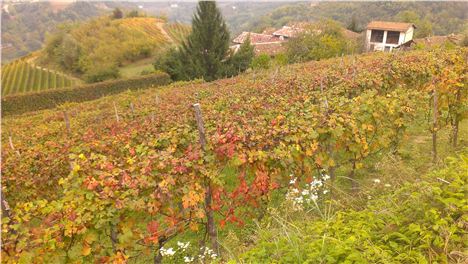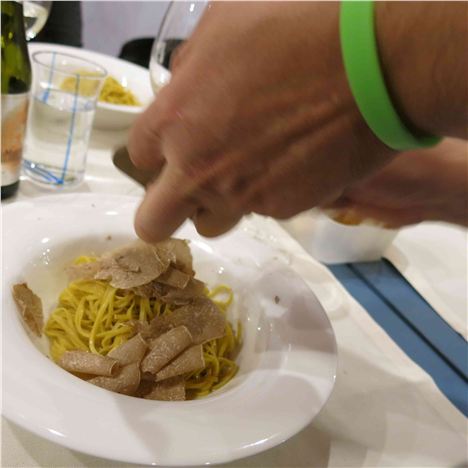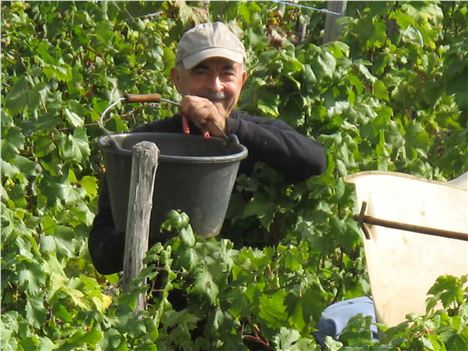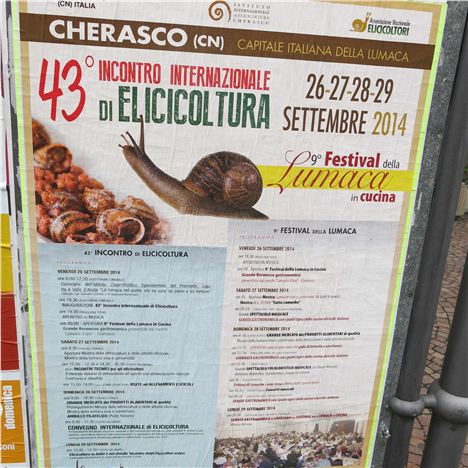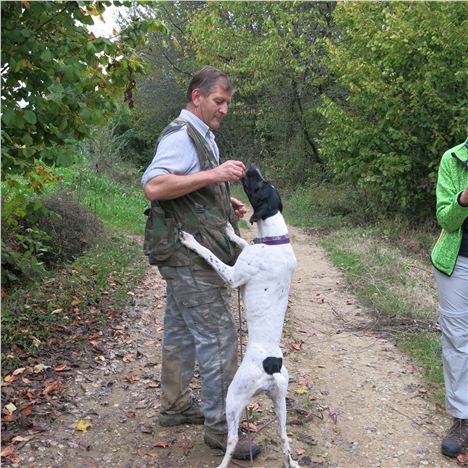FUNNY that. I’d never associated hedonism with tramping through thick forest undergrowth in the dusk. Peering to see if a lean setter-cross has found the ideal tree root to dig frantically under.
I am not alone here in the heart of Alba truffle country in an October unseasonally warm. Around me 15 other paid-up ‘Hedonistic Hikers’, cameras at the ready, also await a tuber epiphany.
'You train your dog to recognise the pungent aroma and then snuffle them out of the earth. It all seems a mite random as Laika zips and zig-zags around, scattering leaf mould, but then...'
Our guides, trading under the name Hedonistic Hiking, are proud to include an authentic white truffle hunt in season as part of their ‘Jewels of Piedmont’ (Piemonte) walking tour. It’s not everyone’s idea of holiday heaven but it sets serious foodies salivating. Those who know what the fuss is all about when the autumn mists that give their name to the famous local grape variety, Nebbiolo, coat the valleys of North West Italy’s Langhe region and the autumn wine harvest is nearly over. It’s Truffle Time, all the way to Christmas.
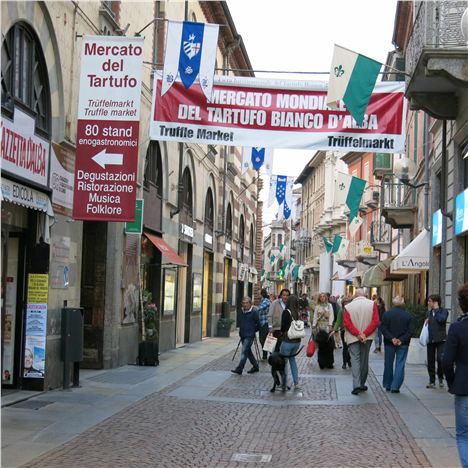 The streets of Alba are paved with truffles – and those hawking them
The streets of Alba are paved with truffles – and those hawking them
 It's Negroni o'clock at the Bar Brasileira in Alba
It's Negroni o'clock at the Bar Brasileira in Alba
The following day we’ll indulge in an early evening aperitivo and do the ‘passeggiata’, strolling around the truffle-scented squares and alleys of regional capital Alba, where the annual Truffle Fair is on to celebrate – and auction off – this lucrative delicacy.
 Marco Varado and Laika lead us into the truffle-rich woods
Marco Varado and Laika lead us into the truffle-rich woods
Still for the moment, at the gourmet equivalent of the coalface, there’s work to be done. Our truffle hunter, Marco Varaldo, expresses faith in his rookie hound, Laika, so new she doesn’t feature in his publicity material. Marco has a day job, but hunting for the lucrative truffles, with their intoxicating, almost aphrodisiac scent, is his passion.
The white variety, the ‘tartufo bianco’, rarer and more expensive than the black and found mostly famously in this corner of Italy, is revered the world over by gastronomes (and expensive restaurants). Admiration isn’t universal – their earthy assertiveness nauseates some sensitive palates. I’m not in that camp.
 Nebbiolo grapes are the last to be picked; below, the spent vines fade
Nebbiolo grapes are the last to be picked; below, the spent vines fade
2104 has been a bad year weatherwise for the winemakers, who fear one of the worst harvests in decades, but the summer dampness foloowed by a dry fall is apparently encouraging a rich harvest of white truffles. They are even threatening to drop in price. It’s all relative, of course, when you note the figures – selling for around €2,000 a kilo, down from €3,500 in 2013 and an eye-watering €5,000 in 2012.
The white truffle can’t be artificially cultivated. This is part of its unique appeal. They are sought for in certain jealously guarded locations, hidden at the base of oak, beech and hazel trees. You train your dog to recognise the pungent aroma and then snuffle them out of the earth. It all seems a mite random as Laika zips and zig-zags around, scattering leaf mould, but then...
 I don’t know what the Piemontese for Eureka is, but it is time to yell it. The pooch apprentice has struck gold – ‘white gold’. Marco quickly straddles Laika, snatching a knobbly clay-covered lump from her jaws, pocketing it and rewarding the dog with a far less expensive treat. We clamber to see what the fuss is about. Marco delicately brushes the muck off the white truffle and we all commune with its pervasive perfume.
I don’t know what the Piemontese for Eureka is, but it is time to yell it. The pooch apprentice has struck gold – ‘white gold’. Marco quickly straddles Laika, snatching a knobbly clay-covered lump from her jaws, pocketing it and rewarding the dog with a far less expensive treat. We clamber to see what the fuss is about. Marco delicately brushes the muck off the white truffle and we all commune with its pervasive perfume.
Over the next couple of hours we collect further specimens and, later, part of the haul, assiduously shaved over the local tajarin pasta, will be the centrepiece of our supper at a little local restaurant called Mange. When truffles are abundant, near the source, they casn be a surprisingly democratic treat.
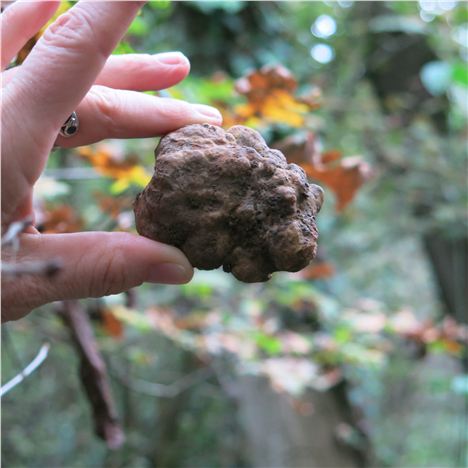 Th first white truffle we unearthed; below, being shaved over our pasta
Th first white truffle we unearthed; below, being shaved over our pasta
We were staying in La Morra, which follows the pattern of all the settlements in the Langhe, which recently attained World Heritage Status. They sit on a hilltop above the vines, dominated by a castle, a church, usually both, and offer ample opportunity to taste the wines that have made this corner of Piemonte famous – Dolcetto, Barbera, Barbaresco (in one small enclave) and, above all, Barolo.
One of of our walks, from our hotel, the Corte Gondina, to Barolo village itself, took in the family-run winery of GD Vajra http://www.gdvajra.itat Vergne. I’d been there before in the early summer (Walking And Wine In Italy's Langhe Hills) to taste their excellent wines and now, the harvest complete, was welcomed back like an old family friend. Piemonte’s like this. It doesn’t feel like some calculating tourist honeypot. You meet it on its own terms.
 An uphill trek for the Hedonistic Hikers
An uphill trek for the Hedonistic Hikers
The same sense of cameraderie pervaded the walking party I had joined half way through their seven day trip. Many of them were Australian, veterans of previous tours run by Hedonistic Hiking’s Mick and Jackie Parsons, who are based in Australia during the winter (Mick is Australian) and the rest of the year in Tuscany when they are not leading tours to different parts of Italy and Slovenia.
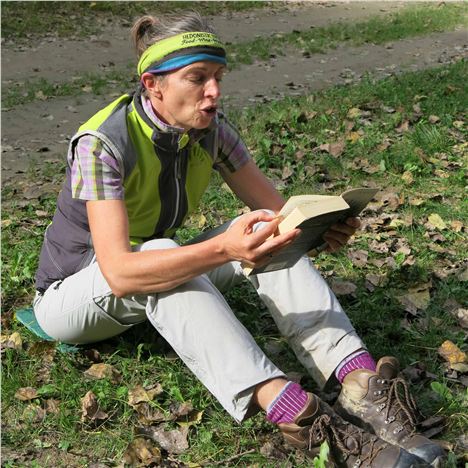 Are you sitting comfortably, hikers? Jackie reads us a story
Are you sitting comfortably, hikers? Jackie reads us a story
Jackie was heading this tour and I liked her quirky style of preceding our gourmet lunchtime picnics (charcuterie, cheese and simpler wines) with a reading. We got Michael Dibdin’s Aurelio Zen mystery, A Long Finish, set in this area and appropriately involving a truffle hunter... and in contrast the stark memoirs of a native, the great 20th century Italian poet Cesar Pavese. Jackie’s concise commentaries on the history and culture filled in the background to a fascinating region. As easy to digest as the fabulous local cheeses we were spoiled with.
 Local bespoke cheeses from Monforte D'alba were the picnic stars
Local bespoke cheeses from Monforte D'alba were the picnic stars
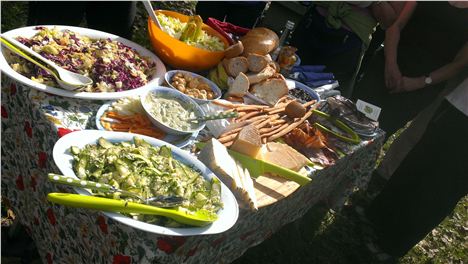 Picnic time outside Barolo village, below
Picnic time outside Barolo village, below
The harder treks had been in the initial part of the trip in rough terrain around the 3,841m high Monte Monviso. I got the easier leg, consisting of half day walks, surprisingly gentle, allowing for differing fitness levels in the group, few of whom were under 40. Still it was enough to raise an appetite for evening meals, each again cunningly designed to showcase the cooking of the region and its wines.
 Food is treated with rare respect here – from the elderly farmer’s wife we came upon picking zucchini from her garden for lunch to the artisan chocolate maker in the historic town of Cherasco (well worth a visit, its palaces and churches hinting at its past importance). Our rest day coincided with our arrival in La Morra and gave us the opportunity to indulge in a long gourmet lunch, with stunning views, at a restaurant called Bovio. So pleasing to see at noon a restaurant full of folk, including well-behaved children paying huge attention to several courses.
Food is treated with rare respect here – from the elderly farmer’s wife we came upon picking zucchini from her garden for lunch to the artisan chocolate maker in the historic town of Cherasco (well worth a visit, its palaces and churches hinting at its past importance). Our rest day coincided with our arrival in La Morra and gave us the opportunity to indulge in a long gourmet lunch, with stunning views, at a restaurant called Bovio. So pleasing to see at noon a restaurant full of folk, including well-behaved children paying huge attention to several courses.
It is no surprise that the global movement, Slow Food, began in these hills. We were sorry to have just missed the appropriate Snail Festival in Cherasco and the Tripe Festival in Alba. There were consolations, not least in the wine, the raison d’etre (I don’t know the Italian equivalent) for everything here. What could be more enjoyable than walking through russet-turning vines all day, then each evening sampling the delectable wines they produce? Definitely Hedonistic.
What is White Truffle?
 Truffles are the fruiting body of a subterranean fungus usually found in close association with the roots of trees, their spores dispersed through fungivores (animals that eat fungi). Hence it was traditionally pigs that were trained to hunt these coveted delicacies. These days it’s more likely to be dogs. White truffles are more highly prized than the black. Growing symbiotically with oak, hazel, poplar and beech and fruiting in autumn, they can reach 12 cm diameter and 500g, though they are usually much smaller, between 30g and 110g. The flesh is pale cream or brown with white marbling which releases their powerful scents, not appreciated by everyone (let’s call it olefactory Marmite!). There an estimated 200,000 regular truffle gatherers in Italy, with the sector worth around €400 million a year. Fresh truffles should be consumed more or less immediately although they will last for up to seven days in a domestic fridge.
Truffles are the fruiting body of a subterranean fungus usually found in close association with the roots of trees, their spores dispersed through fungivores (animals that eat fungi). Hence it was traditionally pigs that were trained to hunt these coveted delicacies. These days it’s more likely to be dogs. White truffles are more highly prized than the black. Growing symbiotically with oak, hazel, poplar and beech and fruiting in autumn, they can reach 12 cm diameter and 500g, though they are usually much smaller, between 30g and 110g. The flesh is pale cream or brown with white marbling which releases their powerful scents, not appreciated by everyone (let’s call it olefactory Marmite!). There an estimated 200,000 regular truffle gatherers in Italy, with the sector worth around €400 million a year. Fresh truffles should be consumed more or less immediately although they will last for up to seven days in a domestic fridge.
Marco Varaldo’s Dal Trifolao Truffle Tours: www.daltrifolao.com
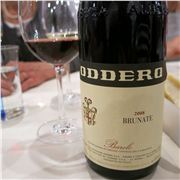 What is Barolo?
What is Barolo?
Regarded as one of Italy’s finest red wines, Barolo is made from the ethereal, challenging Nebbiolo grape in a specified DOC section of Piedmont. They used to take more than 10 years to be ready for drinking thanks to the tannins created by extensive aging in large wooden casks. Nw wave winemakers introduced speedier fermentation and aging in small French barrels for fruitier earlier drinking. Purists said this wasn’t true Barolo, which should boast aromas of tar, earth, strawberries, coffee and truffles (naturally) – delicate and subtle, not a dark-colored, extracted, fruity wine that reeked of oak and vanilla. After the ‘Barolo Wars’ production has settled into something of a compromise. I recommend the newly published Barolo and Barbaresco: The King and Queen of Italian Wine (£27.95) by Kerin O’Keefe, Italian editor for Wine Enthusiast magazine. It’s comprehensive and enlightening.
Fact file
Hedonistic Hiking
Their tours are created for a maximum of 16 guests with two experienced and knowledgable guides accompanying them. During these trips, the hikes consist of both gentle and more challenging walks, but are never competitive and a support vehicle is always on hand if guests choose to take a break. Hedonistic Hiking is eco-certified, committed to sustainability and believe in fully supporting small local-run businesses.
boutique hotel in the village La Morra complete with swimming pool. Prices start from £2,075 per person, based on two people sharing, with a single supplement of £160. This includes, 7 nights accommodation, 2 guides, all meals and wine, support vehicle, return transfers from Turin, luggage transfers, museum visits and tastings. For more information, visit this link or call +44 (0)1858 565148.
Getting there
Return flights from Manchester to Milan start at £83 with Flybe.
Truffle hunting with Laika










